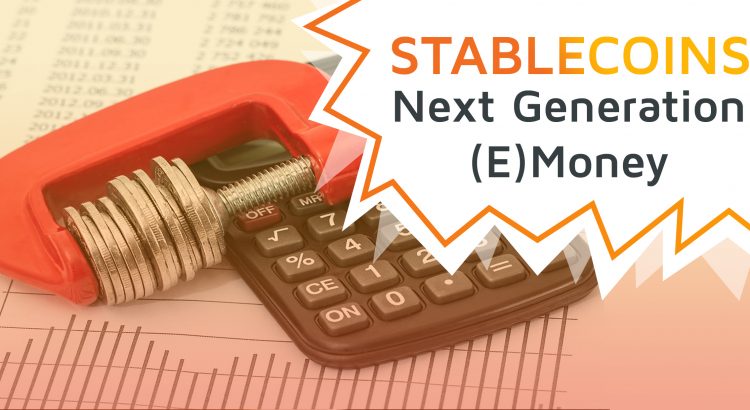
what role stablecoins will
play in the emoney sphere.
Definition: “Stablecoins are cryptocurrencies designed to minimize the volatility of the price of the stablecoin, relative to some “stable” asset or basket of assets. A stablecoin can be pegged to a currency, or to exchange traded commodities (such as precious metals or industrial metals). Stablecoins backed by currencies or commodities directly are said to be centralized, whereas those leveraging other cryptocurrencies are referred to as decentralized” – Wikipedia
Stablecoins by their nature aren’t necessarily a new invention to the financial world. Their basic characteristics have already been described in the first Electronic Money Directive (2000):
“electronic money” shall mean monetary value as represented by a claim on the issuer which is:
(i) stored on an electronic device;
(ii) issued on receipt of funds of an amount not less in value than the monetary value issued;
(iii) accepted as means of payment by undertakings other than the issuer.
What sets them apart from classic emoney, is the underlying technology (blockchain) and the associated advantages. Stablecoins break out of the classic emoney model that is limited to the purpose and infrastructure of the issuing institution / business (i.e. closed loop systems like PayPal).
The issuance of a stablecoin on a decentralized network (ERC20 standard) allows the transfer of funds between businesses and people. Stablecoins can also be repurposed for other forms of financial transactions, like: purchase, trading, security deposit, loan etc., while maintaining a stable price.
What types of stablecoins exist and how are they issued?
Customer trust and compliance with regulatory requirements are the two key factors to successfully establish a new stablecoin. There are many ways to approach this. Here is a breakdown of the most popular methods:
Issuance through a private organization (Centralized)
The most popular stablecoin, USDT, is currently issued by Tether international Ltd., a privately held company. USDT tokens are issued at par value to the amount received in USD fiat (EURT tokens are also available). The tokens are mainly used to move funds across cryptocurrency exchanges today. They increase the efficiency and profitability in cross exchange forex and arbitrage trading through faster transaction times.
USDT and EURT tokens can be bought from the issuing entity, after a deposit in USD or EUR was made.
Since the issuing company is holding customer deposits in its banking account(s), regulatory oversight needs to apply in the state where the entity is situated, including Know Your Customer and Anti Money Laundering measures.
On-chain issuance (Decentralized)
MakerDAO´s DAI token is probably the most prominent example for an on-chain issued stablecoin. The mechanism behind DAI avoids the involvement of fiat currencies despite providing a price-stable token pegged to USD.
The mechanism explained:
To issue DAI tokens, a customer locks up Ether at par value to the expected amount in USD, by using a Collateralized Debt Position (CDP), a smart contract on the Ethereum blockchain. The CDP in return, issues a relative amount of DAI tokens to the value of the locked-up Ethereum tokens in USD. The exact amount of DAIs depends on the collateralization ratio, which is set through active voting by MKR coin holders (MKR is a token that has governance rights over the Maker smart contracts):
100 DAI = 1 ETH = 100 USD (collateralization ratio = 100%)
66 DAI = 1 ETH = 100 USD (DAI backed by 1,5 ETH, collateralization ratio = 150%)
The Ethereum tokens remain locked in the CDP until the customer returns the issued DAI.
MakerDAO has introduced price stability mechanisms to protect DAI holders from losses and Black Swan Events. Explaining these in detail would take this post way too far, but you can find more information in the MakerDAO´s whitepaper.
From a regulatory perspective, MakerDAO operates in a grey legal area. Although no USD funds are involved and regulatory frameworks do not cover on chain issued tokens yet, the interest charged when DAI tokens are returned to the CDP shows characteristics of a lending business, which of course is subject to regulation.
Non-collateralized coins or Seigniorage Shares (Algorithmic)
These are stablecoins where supply is controlled by algorithms written in smart contracts. The algorithm expands or reduces the total supply respectively, to keep the price stable.
These stablecoins have no collateralization to a real-world asset or cryptocurrency. They maintain their value by the promise of future growth which is usually incentivized by bonds and shares.
Algorithmic stablecoin project: Basis.io
What speaks for and against stablecoins as a new form of emoney?
Pro:
- Faster transaction times (P2P compared to moving funds through legacy banking systems to issue emoney with another entity)
- Good conditions of broad market acceptance (if e-currency becomes legal tender)
- Interoperability (breaking out of closed-loop systems)
- Storable offline
- Removes the cost of printing cash and transportation
- Not anonymous and traceable
Contra:
- Not anonymous and traceable
- Yet unknown attack vectors
- Potential risk of bugs in the underlying protocol or the smart contract
The Anonymity Issue
Traditional cash maintains anonymity at all times. This is not true for most currencies issued on a blockchain. Unless explicitly implemented into the protocol (e.g. zk-SNARKs), all transactions remain transparent to the issuer, every transaction can be traced back to its origin and wallets can be monitored.
State-controlled stable coins will surely benefit from this new level of transparency when it comes to fighting financial crime or prevent financing of terrorist organizations. But the average customer will no longer be able to spend a single e-Euro without being monitored by big data analytic algorithms.
Maybe GDPR comes in handy once we get there.
Resume
There is a very good chance stablecoins will become the first crypto product to grow up and reach real mass market adoption. However, this probably won’t happen in their current form.
What we see today is at best a testing environment or blueprint for the development of state-issued stablecoins. Those will only see the light of day once the underlying technological and legal frameworks have reached a level that meets the standards of central banks. It will probably take another decade until we see the first e-Euro in our mobile wallets. But the arguments supporting this type of monetary assets are strong:
- Cash in circulation is massively reduced and therewith the costs for secure printing and transportation
- Counterfeit money is effectively eliminated
- Easier control over circulating supply
- Easier application of sanctions on individuals
- Transparency & traceability to fight financial crime and terror financing
Some states have already made the first steps towards e-currency. Brazil, Russia, Estonia and Dubai have launched piloting projects to evaluate and develop central bank issued stablecoins and many others are looking into it behind closed doors. Interesting related articles:
In the private sector, social networks, messengers and marketplaces are developing their own stablecoins to allow payments and person-to-person money transfers without involving legacy banking infrastructure (SEPA or SWIFT). See for example Facebook, which is developing its own stablecoin.
Exciting times ahead.

